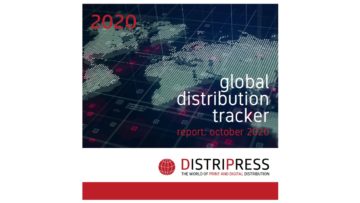This website uses cookies so that we can provide you with the best user experience possible. Cookie information is stored in your browser and performs functions such as recognising you when you return to our website and helping our team to understand which sections of the website you find most interesting and useful.

The press supply chain for both newspapers and magazines (N&M) is facing unprecedented pressure around the world. Yet the industry is squaring up to the challenges and is accelerating changes in how it operates with speed and often great creativity. These are the key conclusions from a new report commissioned by Distripress, the global press distribution trade association, and written by Wessenden Marketing.
“The more agile distribution companies are well into projects that move them from their legacy core operations into the other pipelines.”
The Summer of 2020
During the summer of 2020, Distripress polled a sample of its members about how they were getting through the difficult trading conditions. The resultant “Global Distribution Tracker (GDT) Pulse Update” was published in August and provided feedback from publishers, wholesalers, distributors and retailers in 23 countries in every continent, as it mapped the immediate changes to working practices made as a result of the pandemic.
The topline view then was that although the current state of affairs was volatile, unpredictable and very challenging, it was actually not as bad as many had feared. That was due in part to improvised “workarounds” which were implemented at high speed. These included working from home for office-based staff, social-distancing in warehouses and rejigged delivery runs to retailers. Yet there were also more fundamental supply chain changes taking place. These ranged from minor administrative tweaks through to the emergence of EPoS-based Scan-Based-Trading processes in several major markets. In addition, there have been some major, and virtually universal, shifts in the shares taken by different retail types, with Convenience being the biggest winner and Travel the largest loser. Another key trend seen internationally is that magazines took a bigger pandemic hit than newspapers, but that they will show a more robust clawback in 2021.
“A common theme around the world is consolidation: consolidation of companies and consolidation of processes in order to drive efficiency.”
The bigger picture
The full “GDT Report 2020”, takes a longer-term view, with sales forecasts through to 2024. Although there is still massive turbulence around the world, and both newspaper and magazine single copy print sales are in decline, N&M is still a big business. PwC puts the total revenues of the global newspaper industry at US$93 billion and consumer magazines at US$60 billion. Together, N&M is bigger than Video Games, Music & Radio, Consumer Books, OTT Video or Cinema.
“Publishers need to take a much more creative and proactive look at how to introduce more theatre into selling newspapers and magazines in-store.”
Four content pipelines
In order to serve an increasingly complex media and entertainment world, there are now four basic fulfilment chains running in parallel to deliver N&M content, although these are increasingly overlapping with each other and there are growing differences between newspapers and magazines.
- Pipeline 1: Direct-to-consumer print. This is founded on the postal delivery of print issues with the subscription mechanism being the core payment process. However, payment methods are changing and there is an increasing consumer interest in single-copy home delivery. In addition, the growth of publisher ecommerce requires the home delivery of physical products, either as one-off purchases or as part of an ongoing subscription. This opens up other direct-to-consumer fulfilment options as diversification revenues for Distripress members.
- Pipeline 2: Mediated print. Historically, this is the core of what Distripress members do – the established newsstand supply chain, based on single copy sales in retail shops. Yet retail subscriptions (committed orders fulfilled through retail outlets) form a growing channel in many territories, especially for newspapers.
- Pipeline 3: Direct-to-consumer digital. Here, the range of content products is growing fastest, with the publisher’s own branded website being the core access point for consumers. Other digital products include e-newsletters, video channels, audio (both streamed channels and downloadable podcasts), digital editions, webinars & virtual events, archived content, whitepapers & downloadable resources.
- Pipeline 4: Mediated digital. The mediators of digital content range across social media platforms (eg. Facebook, Instagram, etc), news aggregators (eg. Apple News, Google News etc) and digital newsstands (eg. Readly, PressReader, Cafeyn, Zinio, Magzter, etc), although the distinctions as to what each mediator actually does is becoming more blurred and is increasingly dominated by the major FAANG tech giants.
“Reaching the consumer at home is a major opportunity for existing N&M supply chain players.”
Five big issues
The more agile distribution companies are well into projects that move them from their legacy core operations into the other pipelines. Each link in the current supply chain – whether publisher, distributor, wholesaler or retailer – has a different perspective on the issues and different business models, which are shaping their response to five big questions…
- Issue 1: How to streamline processes in the current newsstand supply chain. There have been some temporary pandemic workarounds, whilst other changes are getting baked permanently into the industry. These range from extending returns cut-off periods, through reducing the number of retail deliveries per week, on to much more fundamental issues such as Scan-Based-Trading and a controlled reduction in the retail universe. It is also clear that the different distribution requirements of newspapers and magazines have been causing tensions and have generated some plans to pull the two supply chains apart in specific countries. Yet a common theme around the world is consolidation: consolidation of companies and consolidation of processes in order to drive efficiency.
- Issue 2: How to develop the changing nature of the in-store experience of physical retailers. This is clearly driven by the retailers themselves as they grapple with the challenges of socially-distanced shopping and invest in in-store tech to enhance the shopper UX. Yet the publishing business needs to take a much more creative and proactive look at how to introduce more theatre into selling newspapers and magazines in-store, otherwise the category will be left behind and marginalised.
- Issue 3: How to reach the consumer at home more effectively and efficiently. This has two distinct dimensions. The first is selling N&M products to consumers, as socially distanced shopping reduces impulse buying and discovery at the newsstands. The second is physically delivering N&M print issues, as well as any additional products generated by publisher ecommerce activity. Reaching the consumer at home is a major opportunity for existing N&M supply chain players. Yet it also brings them into competition with a growing range of companies servicing other FMCG product categories. It also takes them into a world of emerging technologies, such as airborne drones and self-driving delivery robots.
- Issue 4: How to be involved in the other N&M content pipelines by refocusing on marketing rather than pure logistics. A number of logistics companies are developing beyond their core “factory” offer into a wider marketing consultancy role. This means helping publishers with consumer marketing, the most commonly quoted being creating consumer-facing websites for publishers to sell their brands, single copy or subscription, print or digital; and then to manage the fulfilment process as well. It opens up a range of additional marketing services, such as promotional planning & consultancy and the broking of publisher content. This ranges across setting up publishing deals with local publishers, creating and distributing digital editions, broking deals with the digital newsstands, etc.
- Issue 5: How to use existing skills, knowledge and capacity in other, non-N&M supply chains. Again, this has two distinct dimensions. The first is of existing N&M players broadening their press inventory into other categories, notably books, toys, sweets, snacks and confectionery: selling other products to retailers they already supply with newspapers and magazines. Many Distripress members have been doing this for many years already. Yet a number are trying to build scale more rapidly and are testing new categories beyond the more obvious ones.
The second dimension is much more strategic. This means selling their expertise and tech capability into other territories and other categories. There have been attempts to do this in the past, but these have either been unsuccessful or very small scale. The best example of this is Ocado in the UK, which is morphing from a pure-play online grocer, with a small 2% share of the grocery market, into a software provider, management consultancy and project manager. Their clients are grocers in other countries and retailers outside grocery who need to ramp up their online activity rapidly.
“The clear conclusion is that the smarter players will emerge from the pandemic leaner and more efficient.”
Peering into the future
Despite some major differences as to how different companies are dealing with these issues, there are some recurring themes about the future. There will be fewer players in every link in the supply chain, from publishers at the top to retailers at the bottom. This also means a reduction in the number of titles published and in the ranges handled by retailers. There will be fewer range retailers handling N&M. Travel outlets will take a long time to recover.
Also, it is clear that some changes need to be made to supply chain processes in order to make the single-copy print route to market more efficient and robust. Yet how radical those changes need to be varies significantly from country to country.
The bottom line is that there is a long-term future for print, but increasingly this is (1) as premium-priced, lower circulation products and (2) supported and driven by digital tools in the distinct areas of content delivery, consumer marketing and supply chain process efficiencies.
There is no escaping the fact that there will be more casualties along the way over the next few months, in every link in the chain from publishers through to retailers. Yet the clear conclusion is that the smarter players will emerge from the pandemic leaner and more efficient. And also operating in new areas with enhanced digital skills and tools.
The resources behind the Distripress Global Distribution Tracker (GDT) programme are all held on the Distripress website: www.distripress.org
- The “GDT Report 2020” is downloadable at a cost of CHF425 (free to Distripress members).
- The August “GDT Pulse Update” is available free of charge, downloadable for anyone involved in the media business.
- The whole GDT project was discussed in a virtual session at the Distripress Turn the Page Forum in December 2020. A video of the whole forum is available to Distripress members on the Distripress website.
Distripress is a non-profit making trade association established in 1955 to support and promote the global circulation and distribution of press products (newspapers and magazines) in print and digital format. Its members are publishers, printers, wholesalers, distributors and retailers, plus complementary product and service providers, all engaged in the end-to-end press supply chain. The global community has over 200 members in 50+ countries. www.distripress.org
Back to news
